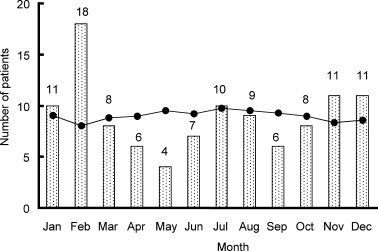SEASONALITY IN THE INCIDENCE OF CONGENITAL HYPOTHYROIDISM IN JAPAN
16 December 2004
Dear Editor,
Congenital hypothyroidism (CH) is the most common congenital endocrine disorder. Patients with CH detected by a screening programme have an abnormality in thyroid development or thyroid dyshormonogenesis. The aetiology of CH is partially understood and it has been shown that one of the causes of CH is gene defect. Three transcription factors, TTF-1 (thyroid transcription factor-1), TTF-2 and PAX-8 (paired box transcription-8), have been found to be important in the development of CH. However, germline mutations in TTF-1, TTF-2 or PAX-8 only account for a small percentage of the causes of CH.1
A previous study has shown seasonal variation in the incidence of CH.2 The seasonal variation suggests that the causes of CH are not only intrinsic factors such as gene defects but also environmental factors. There is controversy regarding seasonal variation in the incidence of CH. No significant seasonality in the incidence of CH was observed in another previous study.3 The purpose of this study was therefore to statistically evaluate the latest trend of seasonality in the incidence of CH in Japan.
Data obtained retrospectively from 108 children with CH who were born in Niigata Prefecture from 1995 to 2001 were used for analysis. Congenital hypothyroidism was detected in the 108 children by neonatal screening and they were examined and treated with l-thyroxine in the Department of Pediatrics of Niigata University Medical Hospital. Clinical and biochemical follow-up was scheduled for 1 month after the start of treatment and then at 2, 3, 4, 6, 8, 10 and 12 months of age. Follow up for patients older than 1 year of age was done every 3 months.
Roger's test,4 Freedman's test5 and the chi-squared test of goodness-of-fit were used to evaluate seasonal variation in the incidence of CH. Roger's test is suitable for a sine-shaped one-phase yearly variation. We used Roger's statistic to test for seasonality after correction for the population at risk and length of the month.3 Freedman's test is suitable for any one-cycle seasonal pattern throughout the year. These tests have higher statistical power than that of the ordinary chi-squared goodness-of-fit test when completely fitting a given model to a set of data obtained. A P-value of <0.05 was considered to indicate statistical significance.
Roger's test statistic of 7.37 was greater than the critical value χ20.05 (5.99) at 2 d.f. This indicates the existence of significant seasonal variation in the incidence of CH at the significance level of 5% (P = 0.025). The same results were obtained by using the other tests (P < 0.05 by Freedman's test, P = 0.047 by the chi-squared test of goodness-of-fit).
Figure 1 shows the actual and expected numbers of CH patients in each month. There is almost no change in the expected number throughout the year, whereas there is remarkable fluctuation in the actual number of CH patients. The highest incidence of CH was in February and the lowest incidence was in May. The number of CH patients in winter (December–February) was the largest among the four seasons. However, there were smaller numbers of CH patients than the expected numbers in spring (April and May) and autumn (September and October).

Seasonal variation in the incidence of congenital hypothyroidism (CH). The bar graph shows actual numbers of CH patients each month (actual) and the line graph shows expected numbers of CH patients each month after correction for the population at risk. The expected numbers were calculated with the assumption of a constant incidence of CH (expected).
The seasonal variation in the incidence of CH suggests that environmental factors (e.g. dioxin exposure,6 viral infection and food) may be important in the development of CH. However, it was found in a previous study that infection with a rubella virus or with any of 20 other viruses was not related to the occurrence of CH.7 Another possible environmental factor is iodine deficiency. However, iodine deficiency is an endemic factor and is therefore not a common cause of CH in many areas. The iodine content in the Japanese diet is very high. Consequently, iodine deficiency is not thought to be a risk factor of CH in Japan.
Seasonal variation of chemical compounds in the environment (e.g. dioxin and polychlorinated biphenyl (PCB)) has been found in previous studies.8 Some studies have suggested that dioxin and PCB have effects on thyroid hormone function.6,9 Sauer et al. found that newborn infants exposed to higher levels of dioxin showed higher levels of thyroid-stimulating hormone.6 Braathen et al. found negative correlations between plasma PCB and the three thyroid hormone variables: free thyroxin, free triiodothyronine and total thyroxin : total triiodothyronine ratio in polar bears.9 These factors are notable risk factors of CH, though there is little evidence that these factors are causes of CH.
It was pointed out that the climate change between seasons might be a reason for the seasonality in the occurrence of CH.3 The reason for seasonal variation in the incidence of CH being reported in only certain areas may be the difference in climate.
The major events in the development of the thyroid gland during the fetal period occur in the first 3 months of the gestation period. Thus, if an environmental factor is involved in the aetiology of CH, the factor must have an effect in the first 3 months of the gestation period. Since the highest incidence of CH was in February in this study, environmental factors might have the greatest effect on the fetal thyroid gland between April and June and this may be the key to determining the risk factors. Further study is needed to elucidate the risk factors of CH.




